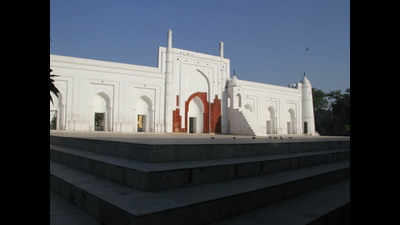- News
- City News
- meerut News
- Lockdown effect: Third time in 800 years, no Eid namaaz at Meerut Eidgah
Trending
This story is from May 26, 2020
Lockdown effect: Third time in 800 years, no Eid namaaz at Meerut Eidgah
For the third time, since it was built 794 years ago, no Eid namaaz was offered at the Eidgah here on Monday.

Over the past eight centuries, the Eidgah witnessed no prayers in 1982 and a decade later, in 1992.
MEERUT: For the third time, since it was built 794 years ago, no Eid namaaz was offered at the Eidgah here on Monday.
The Eidgah was built in the early Sultanate period by Sultan Shamsuddin Iltutmish's son, Nasiraruddin Mahmud. Over the past eight centuries, the Eidgah witnessed no prayers in 1982 and a decade later, in 1992.
Meerut was under curfew due to communal riots on both occasions while this time, it is the coronavirus pandemic that forced devotees to keep away.
Jainus Sajidin, sheher qazi, whose family has been serving at the Eidgah for centuries, said, "Our family has been serving at the Eidgah for the last 300 years. I took over in 1991, after the death of my father who served for 50 years. Prayers are offered at the Eidgah only during the festival of Eid. According to the records and my knowledge, only on two occasions in the past - 1982 and 1992 - prayers were not offered at the Eidgah. Its the third time on Monday."
Interestingly, historians shy away from pinpointing the date when the Eidgah was built, but when it comes to assessing its age by architecture, they too associate it with early Sultanate period.
"While the entire structure has been renovated, a small portion at the front is still reminiscent of the bygone era. Those were the days when bricks were prepared with inscriptions written on them and these are still visible in the exposed old structure. The architecture is very similar to Quwwat-Ul-Islam mosque, considered to be the first mosque to be built in Delhi during early Sultanate period in late 12th century and the beginning of 13th. So it can be safely assumed that the structure was built at that time," said Dr KK Sharma, associate professor, department of history, Multani Mal PG College, Modinagar, and co-writer of "History and Culture of Western Uttar Pradesh".
The Eidgah was built in the early Sultanate period by Sultan Shamsuddin Iltutmish's son, Nasiraruddin Mahmud. Over the past eight centuries, the Eidgah witnessed no prayers in 1982 and a decade later, in 1992.
Meerut was under curfew due to communal riots on both occasions while this time, it is the coronavirus pandemic that forced devotees to keep away.
Jainus Sajidin, sheher qazi, whose family has been serving at the Eidgah for centuries, said, "Our family has been serving at the Eidgah for the last 300 years. I took over in 1991, after the death of my father who served for 50 years. Prayers are offered at the Eidgah only during the festival of Eid. According to the records and my knowledge, only on two occasions in the past - 1982 and 1992 - prayers were not offered at the Eidgah. Its the third time on Monday."
Relating its history, Sajidin revealed, "Meerut's Jama Masjid and Eidgah were constructed almost at the same time. The Eidgah was constructed by Ghiasuddin Balban at the behest of Nasiruddin Mahmud, the son of first Sultan of Delhi, Shamsuddin Iltutmish, in 647 Hijri (1226 AD)."
Interestingly, historians shy away from pinpointing the date when the Eidgah was built, but when it comes to assessing its age by architecture, they too associate it with early Sultanate period.
"While the entire structure has been renovated, a small portion at the front is still reminiscent of the bygone era. Those were the days when bricks were prepared with inscriptions written on them and these are still visible in the exposed old structure. The architecture is very similar to Quwwat-Ul-Islam mosque, considered to be the first mosque to be built in Delhi during early Sultanate period in late 12th century and the beginning of 13th. So it can be safely assumed that the structure was built at that time," said Dr KK Sharma, associate professor, department of history, Multani Mal PG College, Modinagar, and co-writer of "History and Culture of Western Uttar Pradesh".
End of Article
FOLLOW US ON SOCIAL MEDIA











